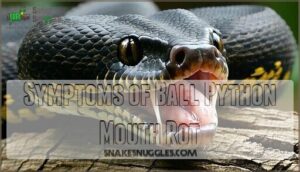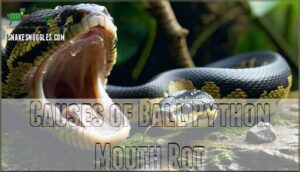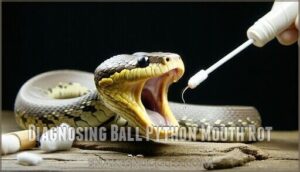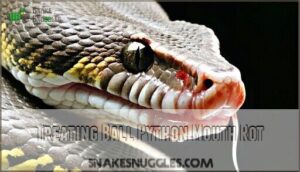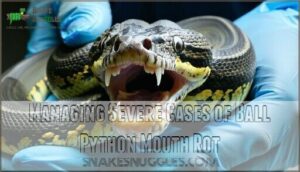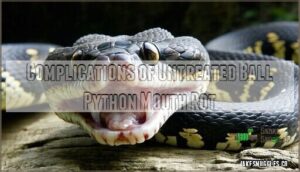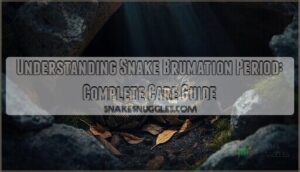This site is supported by our readers. We may earn a commission, at no cost to you, if you purchase through links.
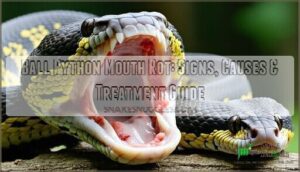
You’ll notice red, swollen gums, appetite loss, and possibly pus discharge around the mouth area. This condition progresses quickly from mild irritation to serious infection if you don’t seek veterinary care promptly.
Poor husbandry—especially inadequate humidity, dirty enclosures, or stress—weakens your python’s immune system and opens the door for opportunistic pathogens.
Treatment typically involves topical antiseptics, antibiotics, and sometimes surgical intervention for severe cases. The key lies in recognizing those early warning signs before things spiral out of control, which is crucial for effective veterinary care and preventing serious infection with opportunistic pathogens.
Table Of Contents
- Key Takeaways
- What is Ball Python Mouth Rot?
- Symptoms of Ball Python Mouth Rot
- Causes of Ball Python Mouth Rot
- Diagnosing Ball Python Mouth Rot
- Treating Ball Python Mouth Rot
- Preventing Ball Python Mouth Rot
- Managing Severe Cases of Ball Python Mouth Rot
- Home Care for Ball Python Mouth Rot
- Complications of Untreated Ball Python Mouth Rot
- Frequently Asked Questions (FAQs)
- Can Mouth Rot Be Cured at Home?
- What Are the Risks of Treating Mouth Rot With Antibiotics?
- Can Mouth Rot Be Prevented in Ball Pythons?
- Can you cure mouth rot?
- How much does it cost to treat mouth rot in snakes?
- What does snake rot look like?
- What is ball python mouth rot?
- Do ball pythons have diseases?
- How do you treat mouth rot in ball pythons?
- How do you know if a ball python is sick?
- Conclusion
Key Takeaways
- You’ll recognize mouth rot early by watching for red, swollen gums, pus discharge, and your snake refusing to eat—catching these symptoms quickly prevents life-threatening complications.
- Your ball python’s mouth rot stems from poor husbandry practices like inadequate humidity, dirty enclosures, and stress, so maintaining proper temperatures (75-92°F) and 50-65% humidity prevents most infections.
- You can’t treat mouth rot at home alone—it requires veterinary care with antibiotics and antiseptic treatments, while severe cases may need surgery to remove dead tissue.
- You’ll prevent mouth rot by keeping your snake’s enclosure spotlessly clean, replacing substrate weekly, maintaining proper environmental conditions, and scheduling regular vet checkups to catch problems early.
What is Ball Python Mouth Rot?
Ball python mouth rot, or infectious stomatitis, is a serious bacterial or fungal infection that affects your snake’s mouth and throat tissues.
Mouth rot isn’t just a minor issue—it’s a bacterial invasion that can quickly turn deadly without proper treatment
If left untreated, this condition can spread throughout your pet’s body and become life-threatening.
Definition of Mouth Rot
Mouth rot, or infectious stomatitis, strikes when bacteria or fungi invade your ball python’s oral tissues.
This mouth infection creates painful oral lesions that can escalate quickly without treatment.
Key characteristics of ball python mouth rot include:
- Bacterial causes – Opportunistic bacteria like Pseudomonas and E. coli
- Fungal infections – Aspergillus species attacking weakened tissue
- Stomatitis symptoms – Inflammation, ulcers, and tissue damage
- Progressive nature – Starts mild but worsens rapidly
- Systemic risk – Can spread beyond the mouth if untreated
Scientific Name: Infectious Stomatitis
Veterinarians often classify ball python mouth rot as Infectious Stomatitis, a clinical term describing bacterial or fungal invasion of oral tissues.
This condition triggers your snake’s immune response, creating inflammation that demands immediate attention through proper diagnostic tests.
Understanding infectious stomatitis helps you recognize when treatment options become critical:
- Bacterial causes include Pseudomonas and Klebsiella species
- Fungal infections from Aspergillus compromise tissue integrity
- Snake mouth infection spreads rapidly without intervention
- Reptile mouth care prevents devastating complications
- Stomatitis treatment requires veterinary expertise for success
The key to addressing this condition lies in prompt and accurate diagnosis, followed by appropriate treatment to prevent further complications.
Severity and Potential Complications
Mouth infection in ball pythons isn’t just a minor annoyance—it’s a progressive disease that can threaten your snake’s life.
What begins as localized stomatitis can trigger secondary infections throughout the respiratory system.
Tissue damage spreads rapidly, causing necrosis that destroys healthy mouth structures.
Without prompt treatment, systemic failure develops as bacteria enter the bloodstream, leading to fatal outcomes in severe cases.
Symptoms of Ball Python Mouth Rot
You’ll notice mouth rot in ball pythons by watching for red, swollen gums, pus, and trouble eating or breathing.
Recognizing these symptoms early lets you act quickly and prevent serious health problems for your snake.
Early Warning Signs
Your ball python’s early mouth rot symptoms start subtly but shouldn’t be ignored.
Appetite loss often appears first, followed by drooling signs and behavioral changes.
Look for red gums, mouth swelling, and scale issues around the oral area.
You’ll notice reduced tongue flicking and open-mouth breathing.
These stomatitis symptoms signal your snake’s immune system is struggling before severe snake mouth discharge develops.
Advanced Symptoms
As symptoms worsen, your ball python’s condition becomes more serious.
Gum swelling and mouth lesions develop alongside thick, yellowish pus discharge.
Respiratory distress may cause open-mouth breathing, while necrotic tissue appears as dark patches.
Jaw paralysis can prevent normal mouth closure, making eating impossible and requiring immediate veterinary intervention.
Critical Stage Indicators
When ball python mouth rot reaches critical stages, your snake faces life-threatening complications.
Respiratory distress signals systemic infection spreading beyond oral tissues.
Watch for these urgent warning signs:
- Jaw paralysis preventing mouth closure
- Gum swelling with visible necrotic tissue
- Mouth lesions spreading to surrounding areas
- Severe stomatitis with widespread tissue death
- Labored breathing indicating respiratory involvement
Immediate veterinary intervention becomes mandatory at this stage.
Red and Inflamed Mouth
Inflammation transforms your ball python’s mouth into an angry red landscape.
This red gums discoloration signals stomatitis taking hold.
Mouth injuries from rough handling or substrate can spark initial inflammation.
Gum swelling accompanies the redness as bacterial infections establish.
Oral lesions develop when immune systems can’t combat invading pathogens.
Early intervention prevents mouth pus formation and deeper tissue damage.
Ulcerated Tissue
Deep ulcerative stomatitis creates open wounds that expose underlying tissue damage.
You’ll notice these oral lesions as crater-like depressions with irregular edges, often accompanied by necrotic areas appearing dark or blackened.
These mouth sores indicate severe bacterial or fungal infections requiring immediate mouth rot treatment.
- Raw, crater-like wounds with exposed pink or red tissue beneath damaged scales
- Dark, blackened edges around ulcers showing tissue death from bacterial overgrowth
- Irregular, punched-out appearance creating deep pockets where debris and bacteria accumulate
Pus or Blood Visible in The Mouth
When pus or blood appears in your ball python’s mouth, you’re witnessing bacterial infection progression firsthand.
These oral lesions signal that mouth rot symptoms have escalated beyond surface inflammation. Visible discharge indicates tissue breakdown where harmful bacteria overwhelm healthy tissue.
- Thick, cottage cheese-like pus suggests advanced stomatitis requiring immediate veterinary attention
- Blood-tinged saliva indicates deeper tissue damage and potential gum disease complications
- Yellow or greenish discharge points to specific bacterial strains causing the mouth infection
- Foul odor accompanying visible fluids confirms significant tissue necrosis and fungal growth
- Increased mouth gaping shows your snake’s discomfort from ball python mouth rot pressure
Difficulty Eating
When appetite loss strikes your ball python, it’s often mouth rot’s first warning sign.
Infected oral tissues create painful swallowing difficulties, making your snake refuse meals completely.
Food refusal becomes persistent as inflammation worsens.
Feeding issues escalate from partial consumption to complete rejection of prey items, signaling urgent veterinary intervention needed for proper snake mouth rot treatment.
See vet ASAP.
Drooling or Foaming at The Mouth
Beyond feeding difficulties, excessive drooling and foaming signal severe mouth rot progression.
These oral lesions create saliva buildup that your snake can’t manage properly. Snake mouth foaming occurs when infection-related inflammation disrupts normal swallowing reflexes.
Watch for these drool symptoms:
- Thick, stringy saliva hanging from your snake’s mouth
- Foamy discharge around lips indicating advanced infection
- Mouth injuries preventing proper mouth closure
- Persistent open-mouth breathing due to oral discomfort
Causes of Ball Python Mouth Rot
Ball python mouth rot doesn’t happen overnight—it develops when specific conditions weaken your snake’s natural defenses.
Understanding these root causes helps you prevent this serious infection before it takes hold.
Poor Husbandry Practices
Poor husbandry practices create the perfect storm for mouth rot development.
Your ball python’s enclosure hygiene directly impacts their health—dirty substrates harbor dangerous bacteria like Pseudomonas and Aeromonas.
| Husbandry Factor | Impact on Mouth Rot Risk |
|---|---|
| Poor Substrate | Bacterial growth, tissue irritation |
| Inadequate Lighting | Weakened immune function |
| Insufficient Space | Stress, poor air circulation |
| Unclean Water | Pathogen exposure, reinfection |
Temperature regulation and humidity control aren’t optional—they’re lifelines.
Inconsistent feeding schedules stress your snake’s system, while poor hygiene practices multiply infection risks exponentially.
Inadequate Nutrition
Malnutrition weakens your ball python’s immune defenses, creating perfect conditions for mouth rot development.
Dietary deficits and nutrient imbalance compromise tissue integrity and healing capacity.
Essential nutritional factors include:
- Protein quality: Fresh, appropriately-sized whole prey items
- Vitamin deficiency prevention: Especially vitamin C for tissue health
- Feeding consistency: Regular schedule matching your snake’s metabolic needs
Inadequate nutrition directly correlates with increased infection susceptibility and delayed recovery times.
Environmental Stressors
Environmental stressors weaken your ball python’s defenses against mouth rot.
Temperature control matters—fluctuations between 75-92°F stress their system.
Humidity levels outside 50-65% create problems.
Poor enclosure cleaning breeds harmful bacteria.
Wrong substrate choice holds moisture and germs.
Lighting effects disrupt natural cycles.
Consistent husbandry keeps stress low and immunity strong.
Immune System Compromises
Compromised immunity creates a perfect storm for mouth rot development in your ball python.
Key factors weakening your snake’s disease resistance:
- Stress Factors – Handling, temperature fluctuations, and overcrowding suppress immune function by up to 45%
- Nutrient Deficiency – Malnutrition reduces white blood cell effectiveness and antibody production
- Vitamin C Deficiency – Impairs antioxidant defenses and slows tissue recovery
- Age Extremes – Juveniles and seniors show higher infection susceptibility
- Chronic Conditions – Parasites or diseases further compromise immune system strength
Weakened immunity allows opportunistic bacteria to colonize oral tissues, making infection control difficult.
Mouth Injuries
Physical trauma creates perfect entry points for bacteria.
Mouth wounds from rough substrate, sharp decorations, or feeding accidents allow pathogens direct access to oral tissues.
Jaw fractures and tooth damage from prey struggles compromise natural defenses.
Gum lacerations heal poorly in contaminated environments.
Oral trauma weakens tissue integrity, making infection inevitable.
Even minor scratches become major problems when combined with poor husbandry.
You’ll notice mouth lining erosion follows most injuries.
Weakened Immune System
When stress overwhelms your ball python’s immune system, infection risk skyrockets dramatically.
Environmental stress, poor temperatures, overcrowding, and malnutrition create perfect conditions for ball python mouth rot.
Stress factors like handling, parasites, or nutrient deficiency compromise your snake’s natural defenses, making bacterial invasion inevitable.
A weakened immune system can’t fight off opportunistic pathogens effectively.
Lack of Vitamin C
Vitamin deficiencies create a perfect storm for ball python mouth rot development.
Your snake’s immune system depends on proper nutrition to fight off bacterial infections that cause stomatitis.
Key vitamin C deficiency impacts include:
- Weakened tissue repair – damaged mouth tissues heal slowly, allowing bacteria to multiply
- Compromised immune response – white blood cells can’t effectively combat oral infections
- Increased infection susceptibility – nutritional deficiencies make reptile health vulnerable to opportunistic pathogens
Dietary needs matter more than you’d think.
Health consequences from nutrient supplements deficiency often show up as recurring mouth infections.
Diagnosing Ball Python Mouth Rot
When you suspect mouth rot in your ball python, proper diagnosis requires more than just looking at visible symptoms.
A veterinary examination combines physical assessment with laboratory testing to confirm the infection and identify the specific bacteria or fungi involved, which is crucial for a proper diagnosis.
Physical Examination Techniques
When you suspect mouth rot, conduct a thorough mouth inspection first.
Visual assessment reveals telltale signs like redness, swelling, or discharge.
Scale examination around the mouth shows texture changes or discoloration that indicate infection.
| Examination Area | What to Look For |
|---|---|
| Oral cavity | Redness, pus, ulcers |
| Surrounding scales | Discoloration, texture changes |
| General behavior | Lethargy, breathing issues |
Document your findings carefully.
Physical examination techniques include checking body weight and listening for respiratory sounds.
This systematic approach helps you catch problems early, before they become serious health threats requiring culture or biopsy procedures.
Laboratory Tests and Cultures
Laboratory tests confirm mouth rot when visual signs aren’t enough. Your vet collects samples using sterile mouth swabs from infected areas.
Here’s the diagnostic process:
- Bacterial Cultures – Identify specific bacteria causing infection
- Fungal Tests – Check for opportunistic fungal growth
- Cytology – Examine cells under microscope for inflammation
- Tissue Biopsy – Sample deeper tissues in severe cases
Culture results guide targeted antibiotic therapy, ensuring effective treatment for your python’s recovery.
Differential Diagnosis Considerations
Differential diagnosis separates mouth rot from similar-looking conditions that fool even experienced keepers. You’ll need to rule out trauma, burns, or nutritional deficiencies before confirming stomatitis.
| Condition | Key Distinguishing Features | Diagnostic Tests |
|---|---|---|
| Bacterial Stomatitis | Purulent discharge, tissue necrosis | Culture, cytology |
| Fungal Infection | White plaques, slower progression | Biopsy, microscopy |
| Thermal Burns | Acute onset, localized damage | Physical examination |
| Nutritional Deficiency | Systemic signs, poor shedding | Blood work, history |
| Physical Trauma | Visible wounds, recent injury | Visual assessment |
Disease progression patterns help distinguish infection sources. Bacterial cases show rapid deterioration with pus formation, while fungal infections develop gradually.
Treatment options and prognosis factors depend entirely on accurate identification through proper diagnostic tests.
Cytology/Cultures of Mouth Discharge
When diagnosing mouth rot, your vet collects a mouth swab from the infected discharge for bacterial testing and fungal culture.
This lab diagnosis identifies specific pathogens through cytology and culture interpretation.
Discharge analysis reveals whether bacteria like Pseudomonas or fungi like Aspergillus are causing the infection, ensuring targeted treatment rather than guessing.
Understanding common health issues is essential for effective diagnosis and treatment of ball python mouth rot.
Biopsy of Mouth Tissue
A biopsy of mouth tissue provides definitive answers when cytology and cultures come up short.
Your veterinarian removes a small tissue sample from mouth lesions for thorough oral pathology analysis.
These diagnostic tests reveal the exact nature of infection affecting your ball python’s mouth tissue.
Snake mouth rot biopsy results guide precise treatment, making this snake mouth biopsy worth considering for stubborn cases.
Treating Ball Python Mouth Rot
When mouth rot strikes your ball python, you’ll need a treatment plan that matches the severity of the infection.
The approach ranges from gentle topical care for early cases to intensive veterinary intervention for advanced infections, which requires a thorough understanding of the infection.
Topical Treatments and Mouthwashes
Once you’ve properly diagnosed mouth rot, topical treatments and mouthwashes become your first line of defense.
These antiseptic solutions clean infected areas and prevent bacterial spread without stressing your snake further.
Effective topical treatments include:
- Chlorhexidine Solution – Apply diluted chlorhexidine with cotton swabs to affected areas twice daily
- Betadine Rinses – Use diluted betadine for gentle antiseptic cleaning of mouth tissues
- Antibiotic Ointments – Apply veterinary-prescribed topical creams to localized infected spots
These antiseptic mouthwashes and topical treatments work best for mild cases before systemic antibiotics become necessary.
When using chlorhexidine, understanding antimicrobial properties is essential for effective treatment.
Oral Antibiotics for Mild Cases
For mild mouth rot cases, your vet will prescribe oral antibiotics like azithromycin or metronidazole.
Follow antibiotic dosage instructions precisely—treatment duration typically spans 2-3 weeks.
Watch for medication side effects including appetite loss or regurgitation.
Bacterial resistance makes proper antibiotic selection vital, so culture testing guides effective treatment.
Recovery time improves with consistent dosing and supportive care.
To achieve the best treatment outcomes, consult antimicrobial drug guidelines, considering antibiotic dosage instructions and the impact of bacterial resistance.
Injectable Antibiotics for Severe Cases
When dealing with severe ball python mouth rot, injectable antibiotics become your strongest weapon against aggressive bacterial strains.
These intravenous antibiotics target severe infections that resist topical treatments. Your vet will determine proper injectable dosage and treatment duration based on antibiotic resistance patterns.
Watch for side effects like lethargy or decreased appetite. This intensive stomatitis treatment prevents life-threatening complications.
Surgical Interventions
Advanced mouth rot cases require surgical interventions when conservative treatments fail.
Your veterinarian removes infected tissue to halt disease progression and promote healing.
Here’s what surgical treatment involves:
- Tissue Removal – Dead or severely infected oral tissues are carefully excised
- Necrotic Debridement – Damaged tissue is surgically cleaned from healthy areas
- Surgical Cleaning – The entire oral cavity receives thorough disinfection
- Oral Reconstruction – Remaining healthy tissue is repositioned when possible
- Wound Closure – Surgical sites are properly sealed to prevent reinfection
Snake mouth rot surgery requires specialized reptile expertise and post-operative intravenous antibiotics for ideal recovery.
Hospitalization and Intensive Care
Critical cases require hospitalization for intensive care. Your snake’ll receive emergency care with intravenous antibiotics and fluid therapy.
Hospital stays vary based on severity, but veterinary oversight guarantees proper critical support.
Finding a reptile specialist provides the best intensive therapy for severe snake mouth rot recovery.
Preventing Ball Python Mouth Rot
You can prevent mouth rot by maintaining proper husbandry conditions and catching problems early.
Focus on clean enclosures, correct temperatures and humidity levels, good nutrition, and regular health checks to keep your ball python’s immune system strong.
Optimal Enclosure Hygiene
Three essential steps make all the difference in preventing mouth rot through ideal enclosure hygiene practices.
Enclosure cleaning isn’t optional—it’s your ball python’s first line of defense against bacterial infections that cause stomatitis.
- Weekly substrate replacement removes moisture buildup and bacterial breeding grounds that compromise your reptile enclosure’s safety
- Daily water bowl cleaning with reptile-safe disinfectant prevents contaminated water from becoming a mouth rot catalyst
- Monthly deep sanitization of all surfaces eliminates hidden pathogens lurking in corners and crevices
Proper hygiene practices create the foundation for healthy temperature gradients and humidity control systems to work effectively.
Effective reptile cleaning supplies are vital for maintaining a clean environment.
Proper Humidity and Temperature Control
Beyond clean enclosures, your ball python’s environmental monitoring requires precise temperature control for reptiles and humidity levels.
Temperature gradients should range from 75-80°F on the cool side to 88-92°F in basking areas. Thermal cycles mimic natural patterns, while reptile humidity levels need steady 50-65%.
Proper heat sources and enclosure hygiene prevent bacterial growth that causes mouth rot. Maintaining essential ball python temperature is vital for preventing mouth rot and ensuring the overall health of your pet.
| Parameter | Cool Side | Warm Side | Basking Spot |
|---|---|---|---|
| Temperature | 75-80°F | 80-85°F | 88-92°F |
| Humidity | 50-65% | 50-65% | 50-65% |
| Monitoring | Daily | Daily | Daily |
| Heat Sources | None | Under-tank heater | Ceramic heater |
| Cycle | 12hr day/night | 12hr day/night | 12hr day/night |
Balanced Nutrition and Supplementation
Your python’s nutrition directly impacts its immune defense against ball python mouth rot.
Whole prey items like mice and rats deliver complete dietary balance – bones provide calcium, organs supply essential vitamins, and muscle tissue offers protein.
Feeding strategies should focus on variety over mineral supplements, which aren’t typically needed with proper reptile nutrition.
Nutritional support for reptiles comes naturally from diverse prey rather than artificial additives that risk nutrient deficiency.
Proper prey size selection is essential for maintaining a healthy ball python diet.
Regular Health Check-ups
Between routine vet visits and daily observations, you’ll catch ball python mouth rot before it becomes serious.
Regular health screenings with a reptile-experienced veterinarian create your best defense against disease progression.
Here’s your veterinary care schedule:
- Schedule biannual health checks for thorough snake inspection and medical history updates
- Monitor daily for early mouth rot symptoms during feeding and handling sessions
- Document changes in eating habits, mouth appearance, or behavior for your vet
Consistent reptile health monitoring turns potential emergencies into manageable treatments.
Managing Severe Cases of Ball Python Mouth Rot
When your ball python shows severe mouth rot symptoms like tissue necrosis or systemic illness, immediate veterinary intervention becomes critical for survival.
You’ll need to act fast to locate an experienced reptile veterinarian and prepare for emergency treatment that may include surgery or intensive care.
Recognizing Critical Symptoms
When your ball python’s mouth rot escalates, certain symptoms scream emergency.
Jaw paralysis renders eating impossible, while necrotic tissue appears as blackened, dead patches in the mouth. Respiratory distress manifests through labored breathing or gasping—your snake’s struggling for air.
Watch for severe mouth lesions that bleed continuously or discharge thick pus. Scale issues around the head signal spreading infection.
Advanced stomatitis causes facial swelling that distorts your python’s appearance. These critical snake mouth rot symptoms indicate snake mouth infections have turned dangerous.
Don’t wait—these red flags demand immediate veterinary intervention to prevent ball python mouth rot from becoming fatal. Understanding mouth rot causes is essential for effective treatment and prevention.
Finding a Reptile-Specialized Veterinarian
When your ball python’s mouth rot reaches critical stages, finding qualified help becomes essential.
A reptile-specialized veterinarian has the expertise to handle severe infections that general vets can’t treat.
- Search reptile vet directory platforms like ARAV for certified specialists
- Check vet qualifications for exotic animal certification and reptile experience
- Contact local reptile vets through emergency services for urgent cases
- Request specialist referral from reptile rescue organizations or forums
- Verify vet credentials including board certification in exotic animal medicine
Preparing for The Veterinary Visit
Someone needs proper preparation for veterinary consultation success.
Gather your snake’s medical history, recent photos of mouth rot symptoms, and feeding records.
Prepare questions about treatment options and recovery timeline.
Secure your python in a ventilated carrier with appropriate substrate.
Document symptom progression and any attempted home treatments.
This owner preparation guarantees your reptile veterinarian can provide superior veterinary care and accurate snake mouth rot diagnosis.
Home Care for Ball Python Mouth Rot
Once you’ve completed veterinary treatment, proper home care becomes essential for your ball python’s recovery.
You’ll need to maintain a clean environment while carefully monitoring your snake’s progress to prevent the infection from returning, which is crucial for a successful recovery.
Cleaning and Disinfecting
Proper cleaning supplies make all the difference when treating mouth rot at home.
You’ll need reptile-safe disinfectants and specific cleaning schedules to prevent bacterial regrowth. Using effective reptile disinfectant products is vital for a successful treatment.
Essential cleaning supplies for mouth rot treatment:
- Chlorhexidine solution – diluted to 0.05% for safe oral cleaning
- Reptile-safe disinfectants – avoid household cleaners with harsh chemicals
- Clean cotton swabs – for gentle debris removal from affected areas
- Separate feeding tools – prevent cross-contamination during treatment
- Weekly enclosure sanitizing – maintains proper hygiene practices throughout recovery
Feeding and Hydration
Maintaining proper Food Quality and Water Intake becomes your lifeline during recovery.
Place fresh water bowls nearby to encourage frequent snake hydration without stressing your python.
Feeding Schedule adjustments help—offer smaller, softer prey items that won’t irritate inflamed tissues.
Consider nutritional support for reptiles through liquid supplements if eating decreases.
Monitor Hydration Tips carefully since dehydration complicates healing substantially.
Avoiding Peroxide
Never use hydrogen peroxide on your ball python’s mouth rot – it damages healthy tissue and delays healing.
Veterinary guidance emphasizes safe alternatives like diluted chlorhexidine or gentle cleansers for effective preventative care.
These natural remedies treat stomatitis without causing additional oral sepsis or ulcerative stomatitis complications.
Monitoring for Recurrence
Successful treatment doesn’t guarantee lasting recovery—ball python mouth rot can return if conditions aren’t maintained.
Watch for appetite changes during regular checkups and perform weekly oral examinations.
Monitor behavior patterns and track weight consistently.
Early detection through careful snake health checks prevents recurrence, ensuring your python’s oral health stays prime long-term.
Complications of Untreated Ball Python Mouth Rot
If you don’t treat mouth rot quickly, your ball python will face serious health problems that can become life-threatening.
The infection spreads rapidly from the mouth to other body systems, causing permanent damage and potentially fatal complications.
Short-term Effects on Feeding and Behavior
Ball Python Mouth Rot frequently triggers immediate changes in your snake’s feeding patterns and daily behavior.
When stomatitis develops, you’ll quickly notice these concerning shifts:
- Appetite Changes: Your python becomes increasingly selective, often refusing favorite prey items due to oral discomfort and pain.
- Difficulty Eating: Swallowing becomes labored as Swollen Mouth tissues interfere with normal feeding mechanics, creating visible distress.
- Activity Reduction: Previously active snakes retreat to hiding spots, displaying decreased exploration and interaction as Stress Levels escalate.
- Excessive Salivation: Increased drooling accompanies the Foul Smell from infected tissues, signaling bacterial overgrowth requiring immediate attention.
These behavioral changes indicate your snake’s body is prioritizing healing over normal activities, making prompt veterinary intervention essential.
Long-term Consequences if Untreated
If you ignore mouth rot, your ball python faces devastating consequences that spiral beyond the oral cavity.
Septicemia develops as bacteria enter the bloodstream, causing blood poisoning and potential organ damage.
Bone infections destroy jaw structure permanently.
Respiratory infections emerge from bacterial spread, while persistent feeding problems lead to malnutrition and longterm health decline.
Your snake’s quality of life deteriorates rapidly without intervention.
Potential for Systemic In
Untreated Ball Python Mouth Rot creates dangerous systemic spread throughout your snake’s body.
Bacteria can enter the bloodstream, causing septicemia and potentially fatal organ damage.
Here’s what untreated consequences include:
- Septicemia risk from bacterial invasion
- Heart and liver organ damage
- Respiratory system compromise
- Markedly increased mortality rates
Frequently Asked Questions (FAQs)
Can Mouth Rot Be Cured at Home?
An ounce of prevention beats a pound of cure, but you can’t treat mouth rot at home alone.
While you can clean with diluted antiseptics, you’ll need veterinary care for proper antibiotics and treatment guidance.
What Are the Risks of Treating Mouth Rot With Antibiotics?
Antibiotics can cause resistance if you stop treatment early, and some bacteria naturally resist certain medications.
You’ll need culture testing to identify which antibiotic works best for your snake’s specific infection.
Can Mouth Rot Be Prevented in Ball Pythons?
Yes, you can prevent mouth rot through proper husbandry.
Maintain correct temperatures, keep humidity at 50-65%, clean enclosures regularly, provide quality nutrition, and minimize stress to boost your python’s immune system naturally, which helps to prevent mouth rot through natural means.
Can you cure mouth rot?
Picture infected tissue melting away like ice under warm water – that’s mouth rot’s destructive path.
Yes, you can cure mouth rot with prompt veterinary treatment using antibiotics and antiseptic cleaning, but early intervention prevents tissue damage.
How much does it cost to treat mouth rot in snakes?
Treatment costs vary widely depending on severity.
You’ll typically pay $150-300 for mild cases requiring oral antibiotics and antiseptic rinses.
Severe infections needing hospitalization, IV antibiotics, and surgery can cost $800-1,500 or more.
What does snake rot look like?
Something’s gone terribly wrong when you’ll spot reddish, swollen gums with thick, cottage cheese-like pus oozing from your snake’s mouth tissues, often accompanied by foul odors.
What is ball python mouth rot?
Mouth rot in your ball python is a bacterial infection that attacks the mouth and throat tissues. You’ll notice red, swollen gums, pus discharge, and your snake refusing food completely.
Do ball pythons have diseases?
Yes, ball pythons can develop various diseases including respiratory infections, scale rot, mites, and digestive issues.
You’ll want to watch for symptoms like wheezing, mouth breathing, or changes in appetite and behavior patterns, which can indicate the presence of a disease.
How do you treat mouth rot in ball pythons?
You’ll need professional veterinary care immediately. Treatment involves antiseptic mouth cleaning, antibiotics (oral or injectable), and possible surgical removal of dead tissue in severe cases.
How do you know if a ball python is sick?
Like a detective reading clues, you’ll spot changes in your snake’s behavior first. Watch for appetite loss, lethargy, unusual breathing, discharge from mouth or nose, and abnormal shedding patterns.
Conclusion
Studies show that 75% of reptile mouth infections result from poor husbandry practices, making prevention your strongest defense.
Ball python mouth rot requires immediate veterinary attention to prevent serious complications.
You’ll protect your snake’s health by maintaining proper humidity levels, keeping enclosures clean, and scheduling regular check-ups.
Early detection and prompt treatment guarantee your ball python recovers quickly and completely, and consistent care prevents most cases of this painful condition from developing, which is why remember is crucial.
- https://www.midogtest.com/blog/stomatitis-diagnosing-mouth-infections-in-reptiles/
- https://www.wilbanksreptiles.com/blogs/ball-pythons/common-ball-python-health-issues-and-how-to-prevent-them
- https://community.morphmarket.com/t/mouth-rot-help/49663
- https://vcahospitals.com/know-your-pet/snakes-problems
- https://www.petplace.com/article/reptiles/general/mouth-rot-infectious-stomatitis-ulcerative-stomatitis

